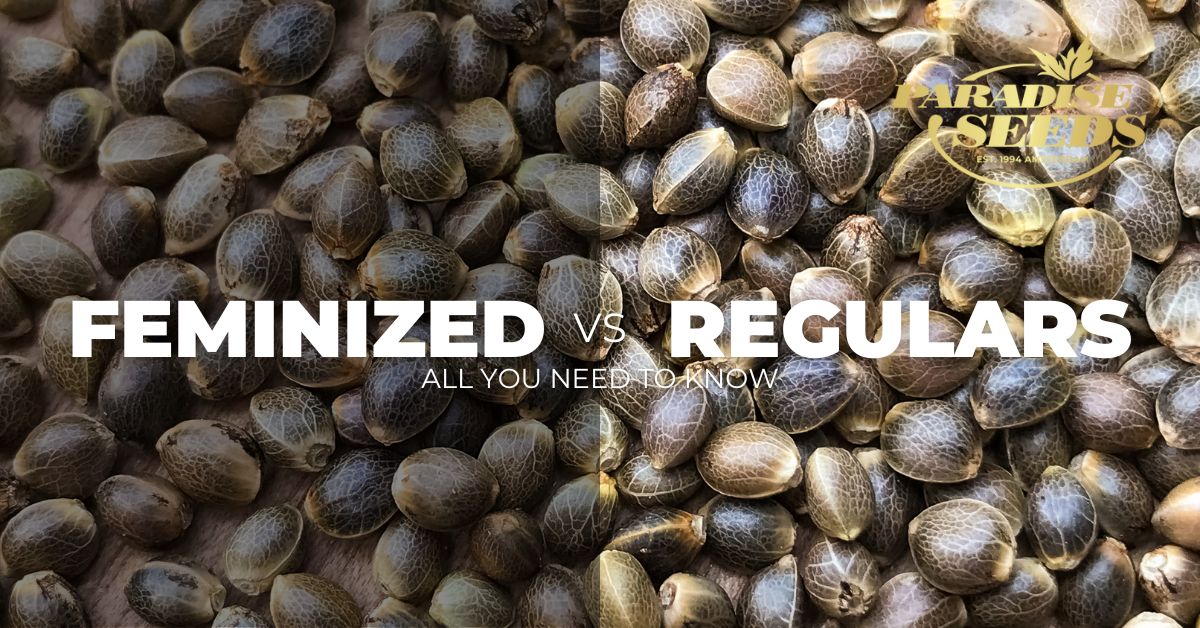The difference between feminized vs regular cannabis seeds has been a popular topic of conversation since feminized seeds began to appear on the scene. When we talk about the unique aromas, yields and cannabinoid ratios of each cannabis strain, we invariably think of female plants.
It is therefore of primary importance to you as a grower whether the seeds you purchase will grow into male or female cannabis plants. The advent of feminized seeds has revolutionized this in recent decades, guaranteeing growers that all plants are female.
Until the late 1990s, purchasing cannabis seeds was akin to a gamble. Regular seeds, which could grow into either male or female plants, left growers at the mercy of chance.
Even the greatest growing gurus will admit that you can’t tell whether a seed will grow into a female or male plant just by looking at its appearance, so you should always expect males when choosing regular seeds.
You need to be alert during development to spot the males in time, because if you move too late and the females are pollinated, you can kiss your crop goodbye.
Since the late 1990s, feminized seeds have been developed to ensure that every cultivated plant is female. This shift has transformed the cannabis cultivation landscape, providing growers with a predictable and efficient process.
This article takes a look at different aspects of the feminized vs regular cannabis seeds debate.
Contents
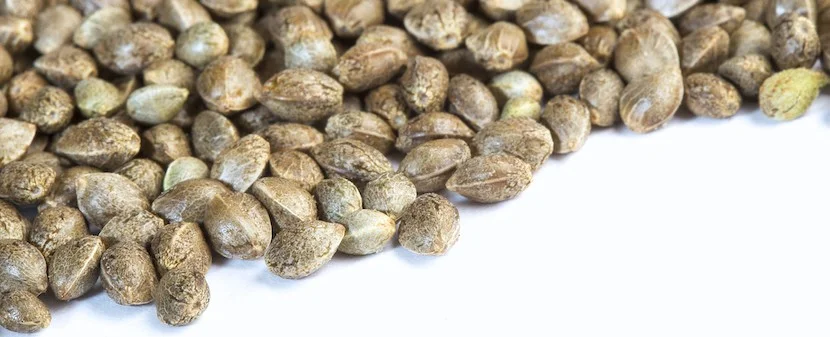
The benefits of feminized vs regular cannabis seeds
Cannabis seeds are inherently half male to half female, as is common in other species in nature. So, if you choose regular seeds, you will need to sow twice as many seeds as you will be able to harvest.
With feminized seeds, whether sativa, indica or hybrid, you can plan more precisely to streamline the growing process in space and time. This is of prime importance if you live in a country where the law specifies the maximum number of cannabis plants you can grow and if you are producing for medicinal purposes.
But if you have a small indoor grow room where you don’t want the males to take up unnecessary space and enjoy the luxury of growing conditions you provide, you may want to consider feminized seeds.
Feminized seeds have a 99% chance of sprouting female plants, so the probability of seeing male sexual characteristics on your plants in the weeks after flowering is negligible.
The elimination of males by using feminized seeds ensures a worry-free experience, especially for growers not interested in breeding or producing new seeds.
The benefits of regular vs feminized cannabis seeds
So it may seem as if there is a sure winner in the feminized vs regular cannabis seeds competition, but many people still rely on regular seeds today. This may be partly the result of habit and aversion to newer technologies, but there are usually practical reasons.
Those who choose regular seeds will also have male plants, so they can cross-pollinate their plants and breed new varieties.
Many people report the experience that females from regular seeds are larger, stronger, and more resistant to temperature challenges and other stressful situations. It is also claimed that they can produce healthier clones from females developed from regular seeds.
And last but not least in the conversation about feminized vs regular cannabis seeds, it is worth mentioning that regular seeds are usually cheaper than feminized ones. But if you want to harvest buds from your regular seed plantation, you will need to get rid of the males early in the development.
In summary, while regular seeds still have their place, feminized seeds have become the preferred choice for those seeking a straightforward and reliable growing process.
How are feminized cannabis seeds created?
Creating feminized seeds – Methods
There are several methods for creating feminized seeds. Still, the basic principle is common: you need to get a female to produce male sex characteristics – mainly pollen sacs and pollen in them – that he can use to fertilize another female.
The resulting seeds will lack male chromosomes and therefore always produce female offspring. This process is called feminization, and the resulting seeds are also called feminized.
Several substances can be used in the chemical method to achieve this goal. The most commonly used is a hormone called gibberellic acid, while you can also choose silver colloid or silver thiosulphate solution.
When used as a spray, these compounds inhibit the formation of the hormone responsible for flowering, ethylene. Flowering is reduced or eliminated without ethylene, and male sexual characters develop instead.
The effect of these compounds is local, meaning that they only affect the branches where they are sprayed. The rest of the plant will continue to flower.
Creating feminized seeds – natural method
Although the name may suggest otherwise, the chemical-free, “natural” method is more brutal, and the result is more uncertain. It involves subjecting the cannabis plant to severe stresses – such as excessively long periods of light or high temperatures – that trigger the survival instinct.
The plant then grows pollen sacs and produces pollen to save what can be saved and to self-replicate its genetics into its offspring. However, this method often leaves its mark on the offspring, leading to hermaphroditic plants.
The last thing the grower wants to see for his money is a stressed hermaphrodite that pollinates the other healthy females, preventing them from flowering.
With today’s technology, there is no need to fear that feminized seeds from a reputable seed bank will sprout hermaphrodite plants.
Distinguish between male and female seedlings
Understanding the sex of cannabis plants is crucial for successful cultivation. Sex in cannabis is determined by X and Y sex chromosomes, just like in humans. Female plants carry two X chromosomes, while males carry one X and one Y chromosome.
During the vegetative stage of growth, male and female cannabis plants look the same and cannot be distinguished. Upon entering the reproductive phase, which occurs 3-6 weeks after germination, cannabis plants can be easily identified as male or female based on the pre-flowers that are specific to their sex.
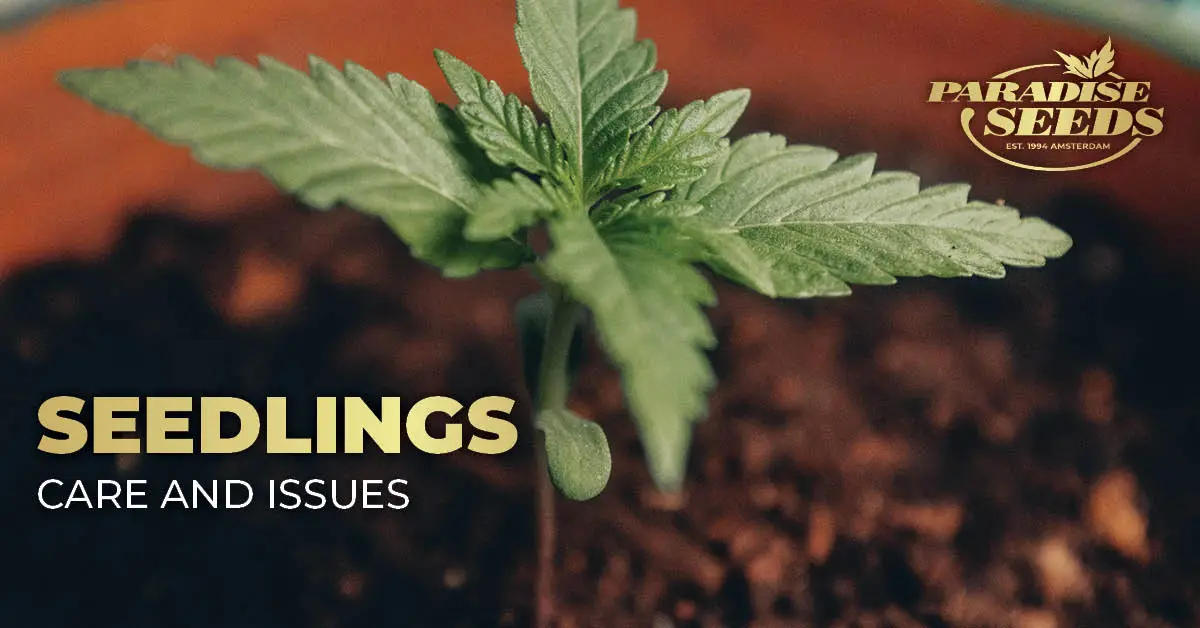
Female cannabis plant characteristics
The female cannabis plant’s reproductive organs consist of three main structures: the pistillate flower, the bract, which is a small leaf tissue from which stigmas emerge; and the ovule, the organ inside the bract that forms the seeds. These structures work together to ensure successful reproduction.
Around 4-6 weeks from seed, small pre-flowers usually appear on female cannabis plants, indicating the beginning of the plant’s sexual maturity. These can be identified by the teardrop-shaped calyxes that grow from the plant’s axils, each of which has two white hairs.
This structure is also known as pistils. The pistil hairs, or stigmas, become gradually darker as they mature, which helps determine the harvest time. Many of these small pre-flowers growing together will become the “buds” we know, containing the largest cannabinoid’ concentration of the plant.
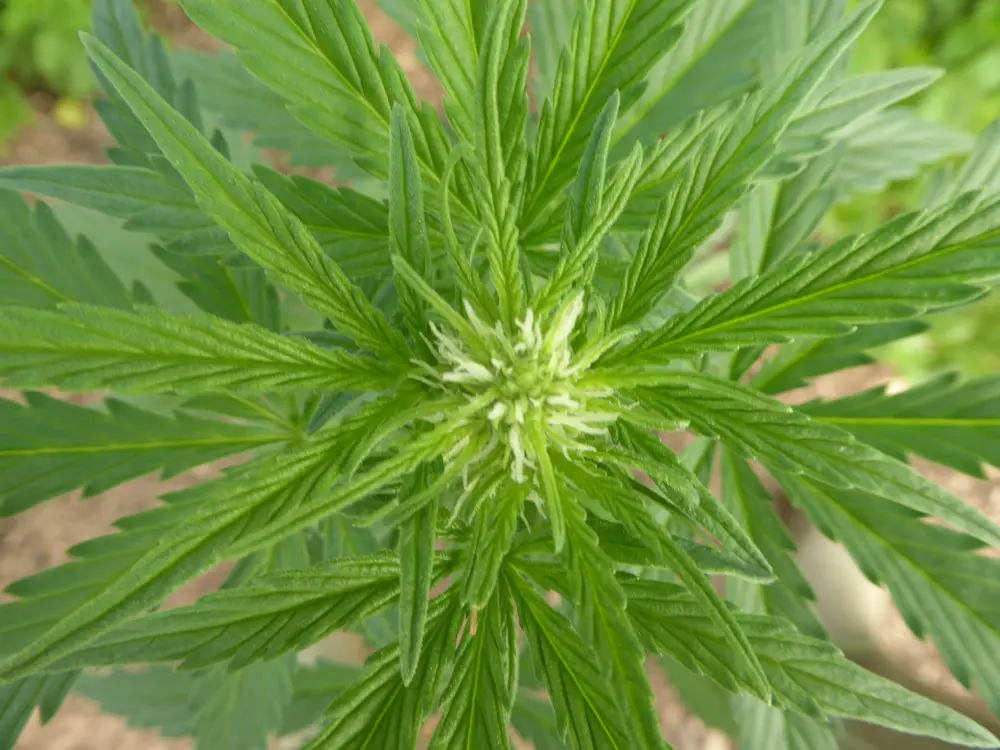
Male cannabis plant characteristics
A male cannabis plant’s sex can be identified by closely examining the nodes around 3-4 weeks after germination. They develop small, round pollen sacks approximately the same size as a cannabis seed.
Compared to a female plant of the same strain, a male plant typically has a thicker stalk as it grows taller and needs to support its weight. Male plants also have fewer leaves than female plants.
Things to check when looking for male cannabis plants
As discussed in relation to the question about feminized vs regular cannabis seeds, if you’re growing regulars, you need to make sure you remove male plants before they can pollinate the females.
- First and foremost, look for pollen sacs (a simple mantra is that a male plant will have balls!). If you see pollen sacs on your plant, remove it from your plantation as soon as you can!
- Male plants typically grow taller during the early vegetative stage, while female plants tend to be bushy and stout with tighter internodal spacing.
- Male plants tend to have wider internodal spacing, meaning the intersections of branching up the main stem are farther apart.
- The calyx (center part of the flower) on female plants will be large and have white hair. On male plants, it will remain small and have no hair.
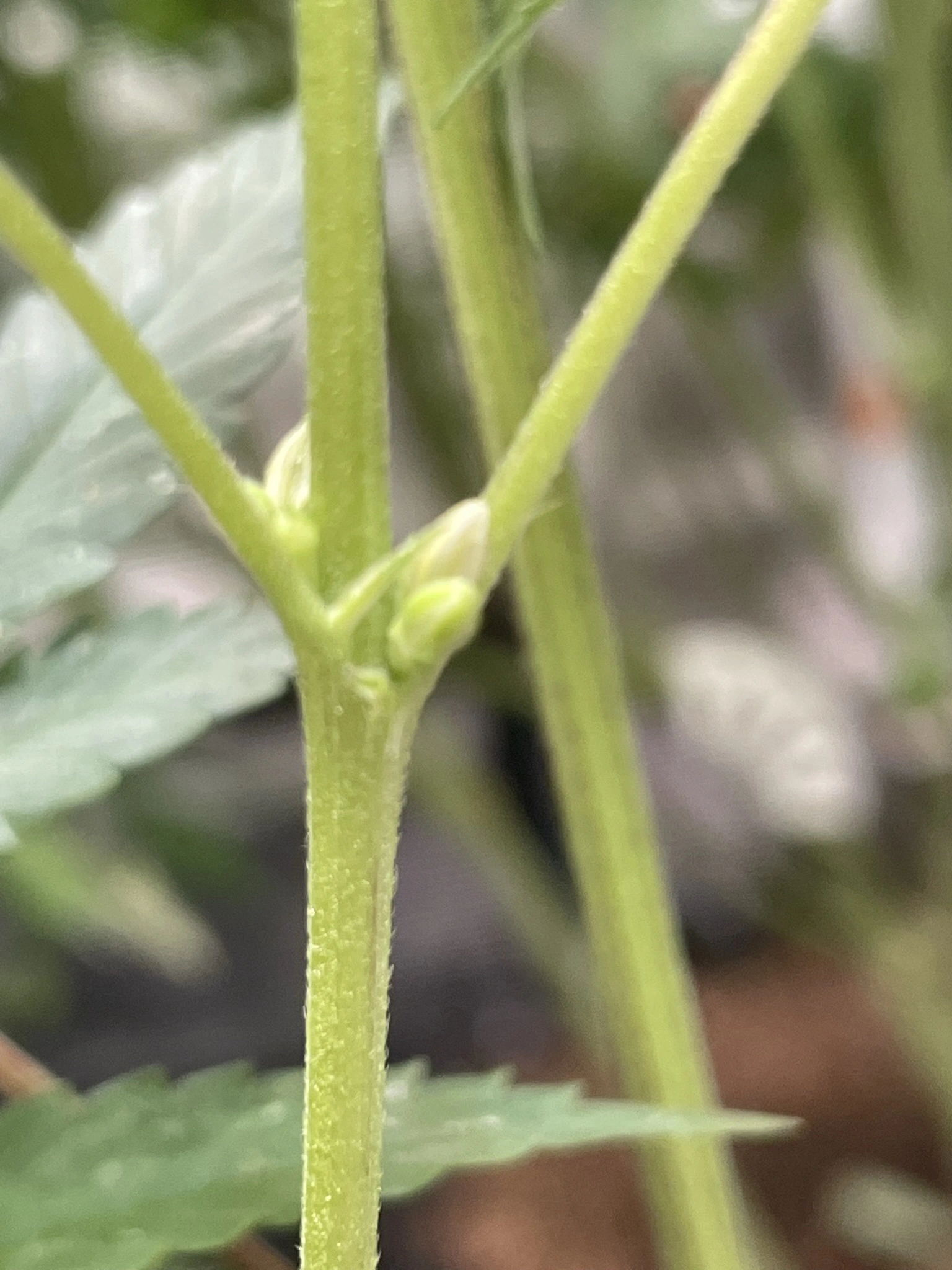
The menace of hermaphrodite plants
As the process of feminization has shown, cannabis plants may have a third sex, that is, hermaphrodites that carry both sexes.
Unless they are created to produce feminized seeds, these usually sprout from poor quality feminized seeds whose parent has been induced to produce seeds by the induction of solid stress effects.
Hermaphrodite plants can also be produced by inappropriate growing conditions, such as exposure to excessively high temperatures, inadequate nutrient supply, root rot, or light leaks during the dark period. These can be such potent stressors that the female plant develops male sexual characteristics to survive.
The bad thing about hermaphrodites is that they can lull you to sleep with the appearance of some female traits. And then when the time comes, they pollinate the female plants, and you can say goodbye to your crop.
So, if you spot hermaphrodites, you should act as you would if you found male plants – remove them from the plantations as early as possible because if you get wise too late, all your crops could be at risk of going to waste.
It’s worth noting that some exotic Californian varieties have a tendency towards turning hermaphrodite. To learn more, check out this dedicated article relating to hermaphrodite plants.
Final thoughts: Making the right choice for your grow
In summary, the choice you should make in the feminized vs regular cannabis seeds debate, depends on your cultivation goals.
Regular seeds may be suitable if you aim to cross-breed, create new varieties, or clone plants. However, for a hassle-free, predictable growing experience focusing on female plants, feminized seeds are the preferred choice.
By selecting high-quality feminized seeds and providing optimal growing conditions, you can ensure a successful and rewarding cannabis cultivation journey.


